
World Premiere Review!
Classy styling and sophisticated sound for
passionate music lovers.
Review By Rick Becker
Source:
enjoythemusic.com
Coincident Speaker Technology
Dynamite Floorstanding Speaker
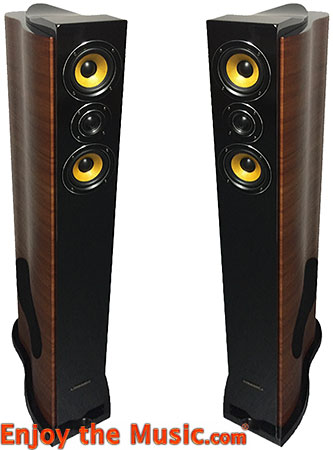
It's no secret that interior design has been trending modern for
quite some time now. The trend was originally labeled
"transitional", a blend between contemporary and traditional
that remains popular with Boomers and Gen X. But "modern", in
the flashback of "Mid-Century Modern" has caught the fancy of
anyone younger than that. In furniture, there is a strong
minimalist theme to Mid-Century Modern, but in a lot of other
categories (think: cars and cutting edge hair styles) there is a
lot of swoopiness happening, and in clothing and personal
accessories (think: watches and jewelry) there is a lot of bling
being bought. I suspect a lot of this is due to the
homogenization of global cultures brought on by the smart phone
with its built-in camera and internet access. Almost everything
can be seen by almost everybody. And a lot of those
"everybodies" aspire to what the wealthy have, as unbridled
capitalism threatens to enslave even the most powerful of
national governments.
While High End audio is certainly a capitalistic enterprise it is
kept in check by its goal of seeking high quality playback of
recorded music. Yet it is not completely impervious to creating
outrageously expensive products affordable by only the top few
percent of civilization. Let's face it. Creative people and
corporations love to create a masterpiece or statement product,
particularly as their life or their company reaches maturity and
their wisdom and experience gains momentum or approaches its
peak. But very few companies can survive solely with the
production of statement products. And there is opportunity in
giving the masses what they want. (In the case of High End audio
"masses" may be a relative term.) The surging popularity of
headphones and the sub-set of High End headphones that
accompanies that surge is a gateway to traditional speaker-based
High End listening. A lot of manufacturers are paying attention
to the possibilities of that gateway and a major trend in High
End audio today is the development of high quality sounding
affordable equipment (again, a relative term) coexisting with
the development of statement products. Which brings me around to
the product under review here.
Israel Blume is an astute businessman as well as a designer of
some of the best High End gear available today. He has worked
hard to keep his manufacturing base in Canada and his speakers
and amplifiers at least moderately priced, if not modestly so.
They aren't inexpensive, nor are they outrageously priced
considering the outstanding performance they deliver at their
various price points. But it's been a long time since they've
offered a full-range floorstander for less than $3000, and given
the trend for high quality affordable equipment mentioned above,
Israel was not about to miss out on the opportunity.
Unfortunately, there was no way the speaker could be built to
that price in Canada, so the cabinets have been outsourced which
allowed for the complex CAD design and high level of finishing.
Still, the Dynamite is completely assembled in Canada near
Toronto.
The Visual Design
There is no way of ignoring the design of the Dynamite as you
take it out of the box, for the speaker itself was designed with
"outside the box" thinking. The curved sides and "Blue Jay"
sculpted cap were purposely designed to reduce internal
reflections. A technique involving extreme pressure and high
heat is used to create the wave shape of the side panels. They
are not milled out of thicker panels, but rolled into the shape
you see. The horizontally applied synthetic cherry veneer over
MDF almost suggests certain high end speakers that were carved
out of stacks of plywood in years gone by, but the Dynamite has
a much higher and more formal degree of elegance. The gloss
black top and bottom caps, connected by the gloss black front
baffle give it an elegant look that, combined with the
D'Appolito configuration of tweeter and midrange drivers with
shinny circular edges and yellow Kevlar cones, give the Dynamite
a sufficient touch of bling to attract younger people. The
Coincident logo blends in almost seamlessly on the lower front
baffle — a rich touch. In a world filled with conventional
box-shaped speakers the Dynamite stands out — Big Time. You'll
have to take my word on that, since you will not find it at your
local high-fi or high-end emporium and the photos on their
website merely suggest how rich the speaker looks in person. In
order to keep its price low, the Dynamite is being marketed
"factory direct".
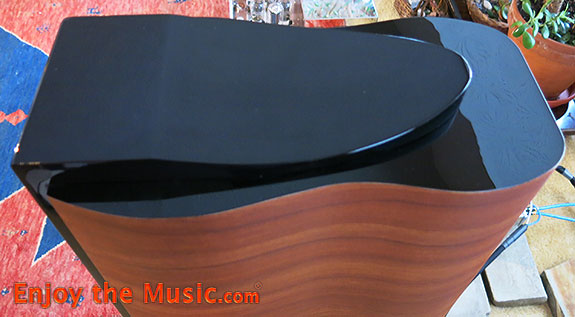
The Internal Design
Inside, the midrange drivers and silk dome tweeter are confined
with their own sealed enclosure, the volume of which was
computer calculated to allow the midrange drivers to roll off
acoustically, without the use of capacitors or inductors in the
signal path. Theoretically, this should improve transparency. To
increase rigidity of the cabinet and improve focus, CAD bracing
was horizontally employed beneath the midrange enclosure and
above and below the woofer. Additionally, a vertical brace runs
from the top of the speaker down through the center of the
cabinet to the horizontal brace above the woofer. Wrapping my
knuckles up and down the side of the cabinet, it was pretty easy
to hear where the bracing was employed. The mid-tweeter
compartment, being smaller, was much higher in pitch and tighter
sounding than the larger woofer cavity. The 2½" flared port of
this bass reflex design is positioned about half way up the back
of the speaker. The binding posts for single wiring only, are
mounted on an aluminum plate near the floor and are high enough
to keep the speaker cable off the carpet when using cable
lifters. The posts are the common plastic covered, gold-plated
design that accept bare wire, banana plugs and spades, and will
not allow your cat's tail to short out the amplifier.
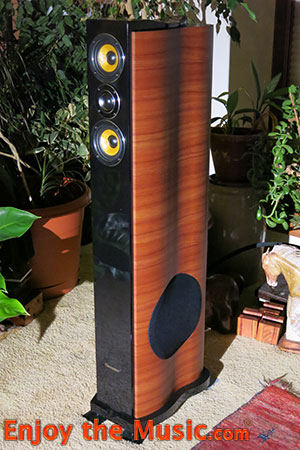
The Setup
The tall (46"), narrow design is a plus for the dispersion of
music from the tweeter and mid-range, but with only a single 8"
woofer, the speaker remains relatively light (48 pounds each)
and has a high-ish center of gravity. The spikes that came with
my early production review sample were slender and were
obviously a cost cutting solution. They were also rather tall,
not screwing into the cabinet very deeply. Consequently, the
speaker seemed a bit vulnerable when bumped.
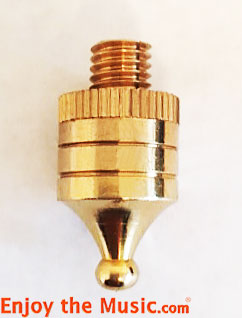
Israel has since upgraded the spikes to a shorter, beefier
design, shown here, which he says adds to the stability of the
speaker. If you have children or large dogs running about, you
might want to invest in aftermarket spike extenders. I made a
similar comment about the Coincident Partial Eclipse II speaker
I reviewed in 2002 and Israel responded with an outrigger spike
design that he uses to this day. I've continued with the
original inset spikes on my Partials, but the grandkids seldom
visit and I've never had a tip-over. The Partial is a heavier
and somewhat shorter speaker at 54 pounds and 38" tall. Since I
must pass close to the speaker to operate my electronic gear
(and do it a lot in the reviewing process) this may be of more
concern to me than a typical listener so simply be aware.
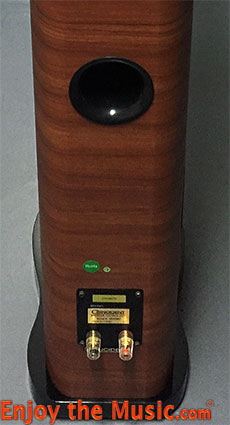
The tweeter height is about 39" on my carpeted floor, two inches
higher than my reference speaker, and I seemed to be looking
slightly upward at the tweeter from my listening chair, about 8'
away. The distance between the speakers settled in at just under
seven feet — a little closer together than usual in my room. And
the baffle of the speaker was a typical 57" in front of the wall
behind the speaker. I did a lot of listening with the speakers
angled toward the outside of each ear, initially thinking this
provided the best sound. Normally, with wide dispersion speakers
such as this, I get the best result facing them forward in my
room. Placing Sound Damped Steel Isofeet (now branded Soundeck)
or Boston Audio Design TunePlates under the spikes increased
resolution a bit, but not as much as with heavier speakers I've
reviewed. I used these square, flat footers throughout the
review. In the course of the saga that follows, I ultimately
reverted back to facing the speakers straight ahead, but your
room and your listening preference will tell you what works best
for you.
Setting The Stage
In the forums and formal press you periodically hear people
complain that reviewers almost never give a bad review, thereby
inferring that the reviewers are in cahoots with the
manufacturer for various reasons. Having reviewed as much
Coincident gear as I have, I'm perhaps even more suspect. And
while I've bought several amplifiers, the only Coincident
speaker I've bought was the first pair I reviewed—the Partials,
mentioned above, which I use to this day in my 2.0 video system.
That's probably because I keep lusting for their Pure Reference
Extreme flagship speaker I can't afford. So it was not a
surprise when Israel asked me to review this new Dynamite. After
all, it was conceived (and undoubtedly voiced) to mate with the
Coincident Dynamo 34SE MK. II which I reviewed and eagerly
purchased. His goal was to create a very high value "entry
level" system that would not only address the higher end
headphone crowd, but serve the next evolutionary step to include
a speaker based option for listening. The Dynamo MK. II is an
excellent tube powered headphone amp capable of driving any
headphone and the original version served as the amplifier in my
killer $5000 Entry Level Project. The Mk. II is essentially the
same amp on steroids. The eight watts coming from each channel
of this 30 pound amplifier were easily sufficient for driving
the Dynamite with its 8 Ohm impedance and 90dB/W/m sensitivity —
even in my large, 6000 cubic foot listening room with large
openings into adjacent areas. Not at head-banging, concert
levels, mind you, but at levels that will allow you to enjoy
your music and retain your hearing well into retirement with
occasional peaks in the 90 to 95 dB range. With a smaller, more
enclosed room, you can of course play louder and suffer the
consequences.
It didn't take long to realize the D'Appolito arrangement tweeter
and midranges was exceptionally resolving.
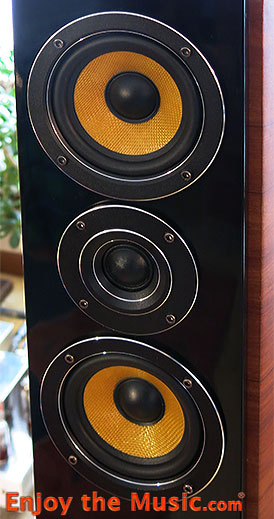
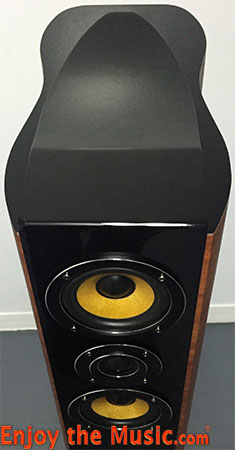
I hit "play" and beautiful music came forth from the Dynamite.
The music from the M-T-M arrangement was not quite as acutely
focused now, but it was smoother and not irritating, and it
blended almost seamlessly into the bass. The soundstage moved
further forward to the plane of the speakers and expanded in
width and depth to what I normally experience with my reference
Kharma speakers. It was music I could listen to endlessly
without tiring. Here was a speaker I could highly recommend.
While the bass was not quite as tightly focused as I would like,
I was asking the 8" driver with a polypropylene cone to move a
lot of air in a big room and perhaps comparing it unfairly to
the 9" Nomex Kevlar driver in the Kharma and the four BilletCore
ultra-high-rigidity woofers in each channel of the YG Sonia XV,
both of which are in entirely different price ranges. The woofer
in the Dynamite was also covered by a permanent grill cloth and
its placement in the concave area of the side of the speaker
made me question the rigidity of its mounting since the flat
basket of the driver is mounted on a curved surface of the
cabinet. The solution must be somewhat tricky but there was no
way I could peer inside to find out. On the plus side, the bass
seemed to go much deeper than the original 38 Hz to 22 kHz
specification on the website suggested.
Once again I pushed aside the listening chair and mounted my
Radio Shack SPL meter on my tripod, right between where my ears
were positioned, slightly below the level of the tweeters. The
measurements validated some important perceptions I have of the
Dynamite. First, a peak in the upper bass region is a room
related peak that appears in all my speaker measurements. The
bass is strong, as I heard, but also goes down to 32 Hz before
falling off significantly. Others have had similar results and
the website now reflects these findings. The midrange and
treble, while not as flat as typical measurements taken on axis
in an anechoic room, are actually reasonably smooth for in-room
measurements from the listening position. That the treble is
down only a couple of dB at 10 kHz shows the strength of this
wide dispersion tweeter. And it being down only 10dB at 20 kHz
is also better than most speakers I've measured. The upper
treble would have measured even stronger if I had angled then
toward the listening position, but I preferred them facing
straight ahead. Like most people who have grown up in
urban/suburban society, I cannot cognitively hear anything that
far out, but the needle danced.
The crossover points are 150 Hz for the bass, which falls within
the room induced peak. The first order roll-off from the
midrange to the bass is accomplished by computer calculation of
the volume of the sealed enclosure for the midrange, eliminating
the need for an active component in the signal path, thereby
increasing transparency. The twin midrange drivers then run from
150 Hz to 4 kHz, covering not only the entire midrange, but a
major portion of the treble as well. Most of the fundamental
range of most of the instruments falls within this range as
well, with the exception of some instruments such as piano and
organ that exceed this range in both directions, and instruments
like brass horns, wind instruments and drums that are designed
to dip into the bass region. Harmonics of most instruments will
extend into the treble region, but at lower volume. As with the
mid-range and bass, there is only a single electronic component
in the first order crossover to the treble. Consequently, with
the Dynamite there is a lot of continuity teaming up with a high
degree of transparency that makes for an easy leap of the
imagination to being in the venue of the music, whether it is a
live recording or a concocted studio creation.
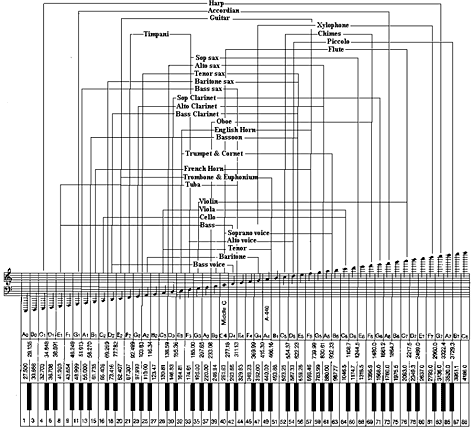
While the Dynamite does not get down to 20 Hz with any authority,
I think most people would readily call this a full-range speaker
and be more than satisfied with it for most kinds of music. Its
strengths include its excellent transparency and focus,
particularly in the midrange and treble. The treble was never
hissy. While the "S"s were sharp when the recording was such
(Paul Simon's Diamonds on the Souls of Her Shoes) the treble
retained control without crossing over into irritating
distortion. Cognitively, the Dynamite pulled lyrics out of the
groove that were previously too obscure for me to decipher.
Brass instruments had authentic bite. The bass was strong and
tuneful but in conveying timbre ("Planet Drum") it was not quite
as excellent as the midrange and treble. When wearing my
"analytical" cap this was noticeable, but when that cap was off
it was very easy to get into the music, reveling in the
revelations this speaker brought to familiar music and simply
enjoying the music that was new to me. Leonard Cohen's "You Want
It Darker" cut right to my soul and will show young adult's
what's behind the mask of their grandparents. When the music
demanded it, the listening experience was emotional. Even rap
music, while not my favorite genre, was especially well
communicated through the Dynamite with its strong bass and
articulate vocals.
The Dynamite does not get in the way of great recordings and it
is sensitive enough to reveal the differences in the components
upstream. My saga with the poorly chosen signal path is an
extreme example, but the Coincident Dynamo Mk II, the Coincident
Turbo 805 SE and even the solid state Musical Fidelity A3 each
imparted their particular strengths and shortcomings to the
Dynamite while allowing very enjoyable appreciation of the
music. With a 90dB/W/m efficiency, 8 Ohm load and easy-to-drive
first order crossover makes for an easy load, thus allowing the
use of a wide variety of amplifier types and power output.
Unfortunately, I don't have an affordable Class D amplifier on
hand to try as that will likely be the amp of choice of many
younger people. But if you're willing to explore the High End,
venturing into tube gear is no more risky than buying a
turntable and jumping into vinyl — and a lot of younger people
are doing that these days.
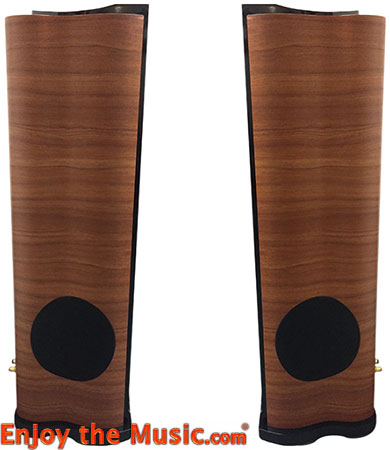
House Sound And Value
While exact memory of the sound of previously reviewed equipment
is difficult, the Dynamite had a very familiar sound that
reminded me not only of the Super Victory and Total Victory
which I have reviewed, but also the Pure Reference Extreme which
I have auditioned. Although the top to bottom coherency of the
Dynamite is not quite as good as these more expensive models
($10k, $15k and $27k, respectively) the resolution,
transparency, dynamics, excellent soundstaging and tube-friendly
efficiency are strengths they all share. Naturally, as you move
up in price you get more refinement and the ability to play
louder in larger rooms. That the Dynamite is starting out with
an introductory price of $2999 is a very high value proposition.
It is also evidence of Israel's commitment to manufacturing
reasonably affordable gear at the entry level of his loudspeaker
and amplifier lines. Furthermore, at the time of this writing,
the Dynamite and Dynamo are being bundled with an enticing
price. That the speaker and the amp are so stylish, both
individually and together, is an added bonus. You will have to
look far and wide to find to find a loudspeaker that sounds this
good and looks this classy at anywhere near its price. If you
do, put a message in a bottle and let me know.
Specifications
Type: Three way, four driver floorstanding loudspeaker.
Frequency Response: 38Hz to 22 kHz
Power Requirements: 8 watts to 100 watts
Sensitivity: 90 dB/W/m
Impedance: 8 Ohms
Dimensions: 46" x 14" x 7.5" (HxDxW).
Weight: 48 lbs. each
Price: Introductory $2999 per pair
Company Information
Coincident Speaker Technology
391 Woodland Acres Crescent
Maple, ON.
Canada L6A 1G2
Voice: (905) 326-9345
E-mail: iblume@coincidentspeaker.com
Website:
www.coincidentspeaker.com




![]()




![]()